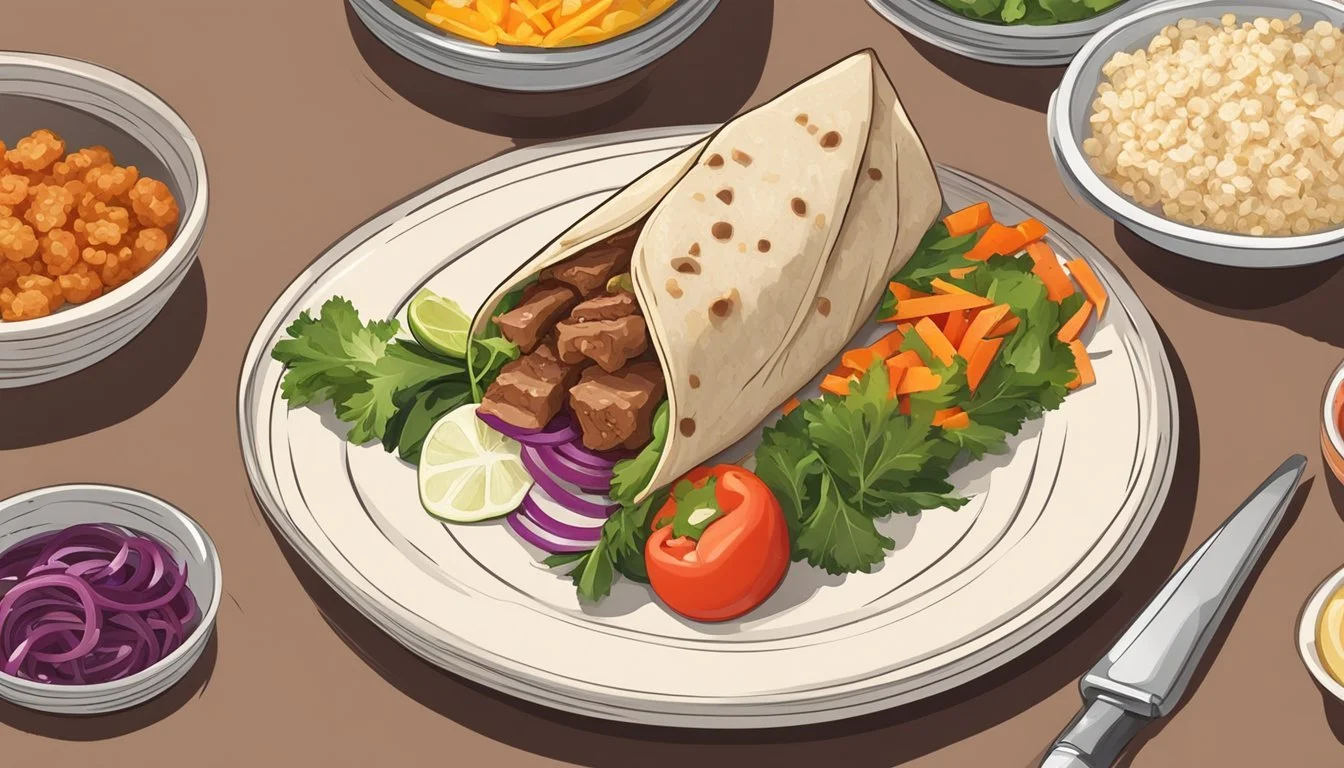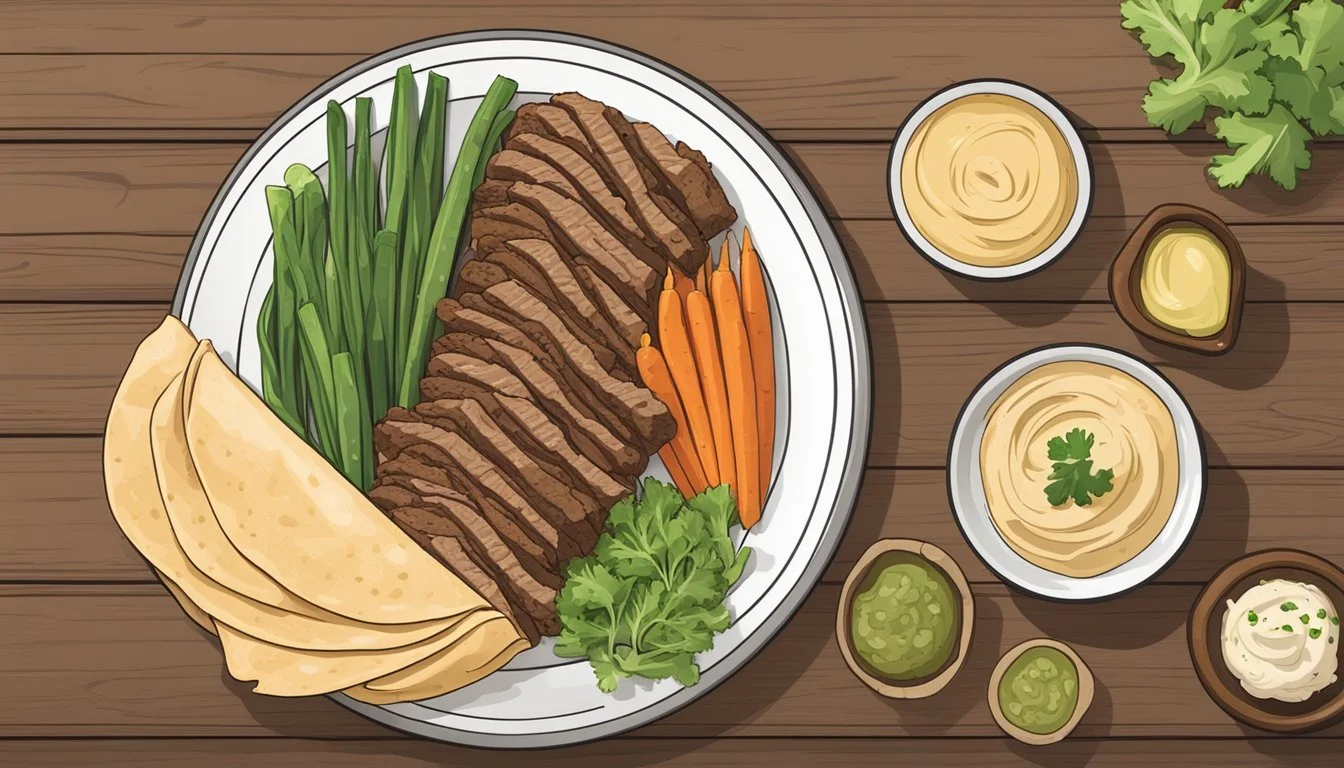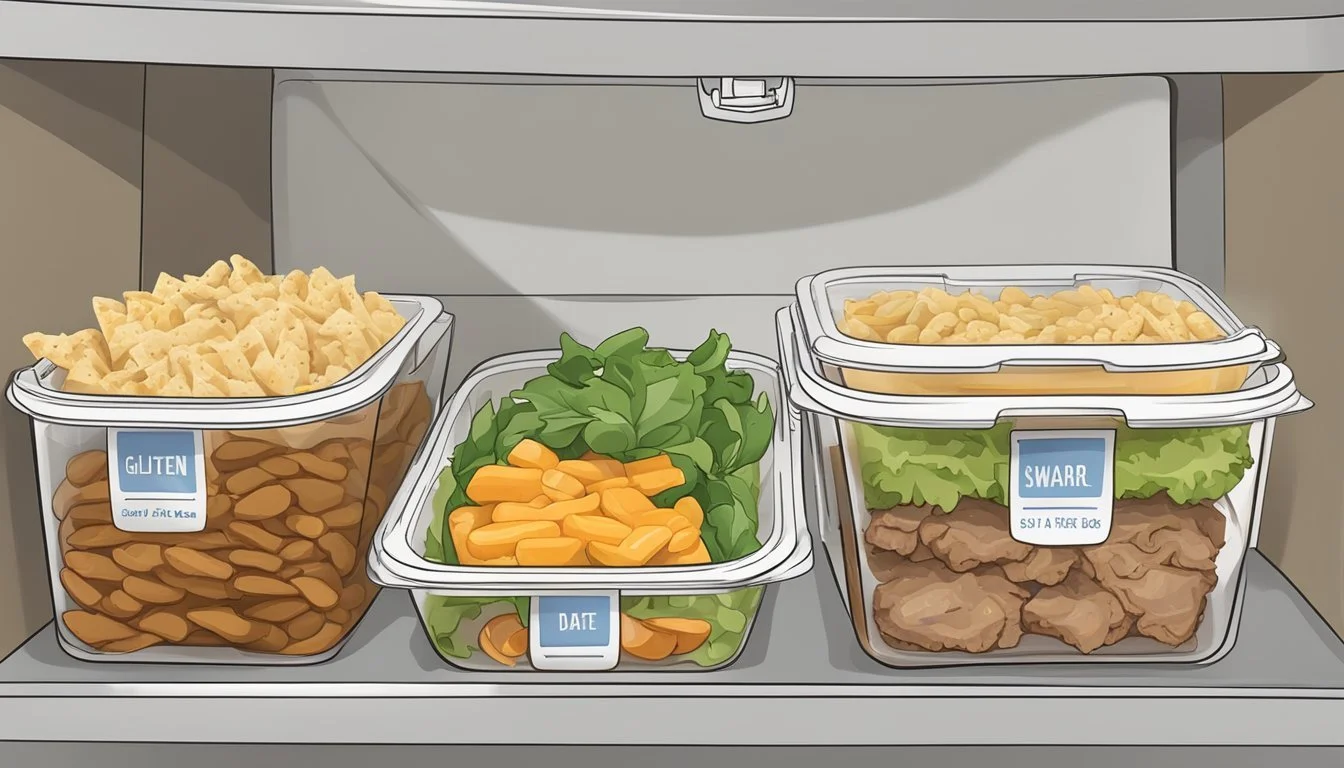How Long Does Gluten-Free Beef Shawarma Last?
Storage and Freshness Guide
Beef shawarma is a popular dish with origins in the Middle East, packed with flavorful spices and typically served in a wrap or on a plate with sides. For those who follow a gluten-free diet, it's important to ensure all ingredients used are free from gluten and to watch out for cross-contamination. Proper storage plays a key role in maintaining its freshness and safety over time.
Gluten-free beef shawarma, when stored correctly in an airtight container, can last up to 3-4 days in the refrigerator. This timeframe ensures that the dish remains safe to eat and retains its flavor. It's essential to cool the shawarma down before refrigerating to prevent any potential bacterial growth that could spoil the meat.
If you wish to extend the shelf life of your gluten-free beef shawarma, freezing is a viable option. By placing it in a well-sealed, freezer-safe container, you can preserve it for up to 2-3 months without compromising its quality. When ready to eat, thaw it in the refrigerator and reheat thoroughly before serving.
Understanding Beef Shawarma
Beef shawarma is a savory and aromatic dish that originates from the Middle East, characterized by its marinated meat, blend of spices, and often served in pita or flatbread. This section details its history, key ingredients, and how it compares to its chicken counterpart.
History and Origin
Shawarma has its roots in the Middle Eastern region, tracing back to the Ottoman Empire. The name "shawarma" is derived from the Turkish word "çevirme," meaning "turning," which refers to the traditional method of cooking the meat on a spit.
Initially, lamb was predominantly used, but over time, beef became a popular variant. The dish spread across various cultures, influencing and being influenced by other cuisines.
Traditional Ingredients
The core components of beef shawarma include marinated beef strips, a blend of spices, and a garlic-based sauce. Common spices used are cumin, paprika, turmeric, and cloves. The meat is marinated in olive oil, lemon juice, and sometimes vinegar, which enhances its flavor and tenderness.
The preparation often includes sliced vegetables like onions, tomatoes, and cucumbers. The dish is served with tahini sauce or yogurt sauce, adding a creamy texture.
Variations Compared to Chicken Shawarma
While both beef and chicken shawarma share similarities in preparation and spices, the type of meat used creates distinct differences in taste and texture. Beef shawarma typically has a richer, more robust flavor, owing to the marbled cut of beef used and its longer marination process.
Chicken shawarma tends to be lighter and less fatty. Additionally, the cooking techniques may vary slightly; beef shawarma might be cooked longer to ensure tenderness, while chicken cooks faster due to its leaner nature.
The choice between beef and chicken often depends on personal preference, dietary restrictions, or the specific flavor profile desired in the dish.
Preparing Gluten-Free Beef Shawarma
This section guides you through the key steps of making a delicious gluten-free beef shawarma, focusing on selecting the right ingredients, marinating the beef with the perfect spice blend, and the best cooking techniques.
Selecting Gluten-Free Ingredients
Start with certified gluten-free ingredients to ensure the shawarma is safe for those with gluten intolerance or celiac disease.
Beef should be fresh and high-quality. Recommended cuts include flank steak or sirloin, as they become tender when marinated.
Spices like cumin, coriander, and paprika must be gluten-free, as some spice mixes contain gluten contamination. Use certified gluten-free spices or mix your own to guarantee safety.
Ensure all other supplementary ingredients, such as yogurt or tahini for sauces, are also labeled gluten-free. Always verify the labels since hidden gluten can be present in many store-bought products.
Marination and Spices Blend
The right marination is key to flavorful shawarma.
Combine spices including cumin, coriander, paprika, cinnamon, and garlic powder with an acidic element like lemon juice or white vinegar. Olive oil aids in blending the spices thoroughly and helps in tenderizing the beef.
Marinate the beef strips in the spice mix for at least 4 hours or up to 24 hours for best results. Longer marination ensures deeper flavor penetration and more tender meat. Cover and refrigerate the marinated beef during this period.
For gluten-free shawarma, ensure all marinade ingredients, including sauces, are gluten-free. This will maintain the gluten-free integrity of the dish.
Cooking Techniques
The cooking method can significantly impact the texture and flavor of the shawarma.
Roasting in the oven: Preheat the oven to around 425°F (220°C). Spread the marinated beef strips on a baking sheet lined with parchment paper. Roast for about 20-25 minutes, turning once to ensure even cooking.
Pan-frying on the stovetop: Heat a nonstick skillet over medium-high heat. Cook the beef strips in batches, ensuring not to overcrowd the pan. This allows the beef to brown properly, giving it a nice crisp texture.
Grilling: Another excellent method is grilling. Preheat the grill to medium-high heat. Cook the beef strips for approximately 3-4 minutes on each side, or until they reach the desired doneness.
Consistency in cooking ensures the beef is tender, flavorful, and maintains the gluten-free promise.
Gluten-Free Shawarma Storage Guidelines
Storing gluten-free beef shawarma correctly ensures its freshness and safety for consumption. Key considerations include proper refrigeration and freezing techniques.
Refrigeration and Shelf Life
Cooked gluten-free beef shawarma should be stored in an airtight container to keep it fresh. Refrigerate it within two hours of cooking to prevent bacterial growth.
Stored in the fridge at 40°F (4°C) or below, gluten-free shawarma can last for 3-4 days. Whether the beef is marinated or cooked, maintaining this temperature is crucial for safety.
Tip: Label the storage container with the date to keep track of its shelf life.
Freezing for Long-Term Preservation
For extended storage, freeze the gluten-free beef shawarma. Place it in a freezer-safe container or heavy-duty ziploc bag, removing as much air as possible.
Frozen shawarma maintains its quality for up to three months. Reheat in the oven or on the stovetop to preserve texture and flavor.
Tip: Portion the shawarma before freezing to make reheating easier and more efficient.
Nutritional Value of Beef Shawarma
Beef shawarma offers a rich blend of macronutrients along with essential vitamins and minerals. Its nutritional profile is valuable for those looking to balance their diet while enjoying flavorful cuisine.
Macronutrient Breakdown
Beef shawarma is calorie-dense, with a serving typically offering around 773 calories. A substantial portion of these calories comes from protein and fat. There are about 24 grams of fat, including 7.9 grams of saturated fat, 2.1 grams of polyunsaturated fat, and 9.6 grams of monounsaturated fat.
The protein content, crucial for muscle repair and growth, is also high due to the beef. Carbohydrates in beef shawarma mainly come from accompanying ingredients like pita bread or vegetables, varying with the specific recipe. Fiber content tends to be minimal unless paired with high-fiber side dishes or toppings like fresh vegetables or whole grain wraps.
Essential Vitamins and Minerals
Beef shawarma is rich in several essential vitamins and minerals. Key among these is iron, important for maintaining healthy blood cells and preventing anemia. The beef also provides zinc, necessary for immune function.
Vitamins A and C might be present in the accompaniments such as fresh vegetables used in shawarma preparations. Calcium content can be influenced by dairy-based ingredients, like yogurt-based sauces.
Sodium content is notable due to seasoning and marinades, which may aid in flavor but necessitate moderation for those monitoring salt intake. Potassium is also present, contributing to cardiovascular health and proper muscle function.
Serving and Accompaniments
Beef shawarma is best enjoyed with a variety of side dishes and sauces that complement its savory and spiced profile. The right accompaniments can enhance the flavors and make for a truly satisfying meal.
Appropriate Side Dishes
Pita Bread: Often, beef shawarma is served with fresh pita bread. The soft, warm pita provides the perfect vessel for wrapping the flavorful beef and other fillings.
Rice: A bed of seasoned rice can also pair well with beef shawarma. Consider using basmati rice with a touch of cumin and parsley for added flavor.
Salad: Fresh veggie salads, such as a mix of chopped tomatoes, cucumbers, and onions dressed with olive oil, lemon juice, and vinegar, offer a refreshing balance to the rich shawarma. Pickles provide a tangy crunch that contrasts nicely with the meat.
Fries: Many enjoy serving beef shawarma with a side of crispy fries. They add a delightful crunch and are perfect for dipping into various sauces.
Suggested Sauces and Dips
Tahini Sauce: A traditional tahini sauce, made from sesame paste, garlic, lemon juice, and a bit of water, is a classic accompaniment. It's creamy and adds a nutty richness to the shawarma.
Garlic Sauce: Also known as toum, this sauce combines whipped garlic with oil, lemon juice, and salt. Its pungent garlicky flavor elevates the taste of the beef.
Hummus: This chickpea-based dip, blended with tahini, olive oil, lemon juice, and garlic, pairs wonderfully not only as a side dip but also as a spread within the shawarma wrap.
Yogurt-based Sauces: A sauce made of yogurt mixed with garlic, cucumber, mint, and a squeeze of lemon juice offers a fresh, cooling contrast to the spices in the beef.
By carefully selecting side dishes and sauces that complement the flavor of beef shawarma, one can create a well-rounded and delightful meal experience.
Tips for Enhancing Flavor and Texture
Enhancing the flavor and texture of gluten-free beef shawarma involves focusing on achieving the right doneness and optimizing the spices. Paying attention to these areas ensures a satisfying and delicious meal.
Achieving Perfect Doneness
Ensuring perfect doneness is crucial for both flavor and texture. Tender beef strips are key. Marinating the beef aids in breaking down fibers, making the meat tender. A marinade consisting of yogurt, lemon juice, and a balanced mix of spices enhances both flavor and tenderness.
For cooking, consider using a cast iron skillet or a grill. The intense, even heat helps sear the meat properly, locking in juices and creating a flavorful crust. Thin, uniform strips will cook evenly and quickly, minimizing the risk of toughness.
Regularly check for doneness using a meat thermometer. Aim for an internal temperature that ensures safety but retains juiciness, typically around 145°F for medium-rare. Rest the meat after cooking to let the juices redistribute.
Optimizing Spice Ratios
The spices used in beef shawarma make a significant impact on its flavor. A traditional shawarma spice mix typically includes cumin, coriander, turmeric, paprika, and garlic powder. Balancing these spices is critical to avoid overpowering the meat.
Start with a base ratio of 1 tablespoon each of cumin and coriander, 1 teaspoon of turmeric, 1 teaspoon of paprika, and ½ teaspoon of garlic powder. Adjust according to taste preferences. Including a bit of cinnamon or allspice can add a subtle sweetness and depth to the mix.
Marination time also affects how flavors penetrate the meat. A longer marination, ideally overnight, allows spices to infuse deeply. Always taste the marinade before adding it to ensure it meets your flavor expectations.







